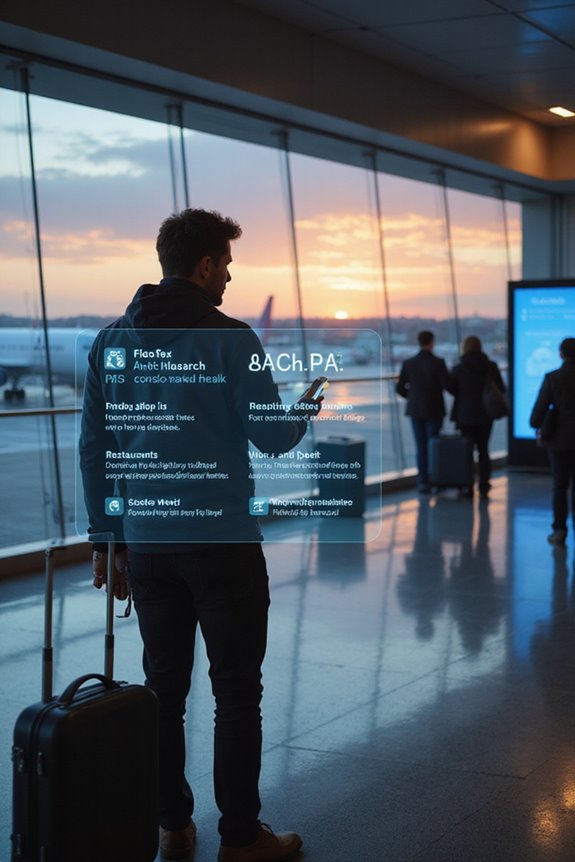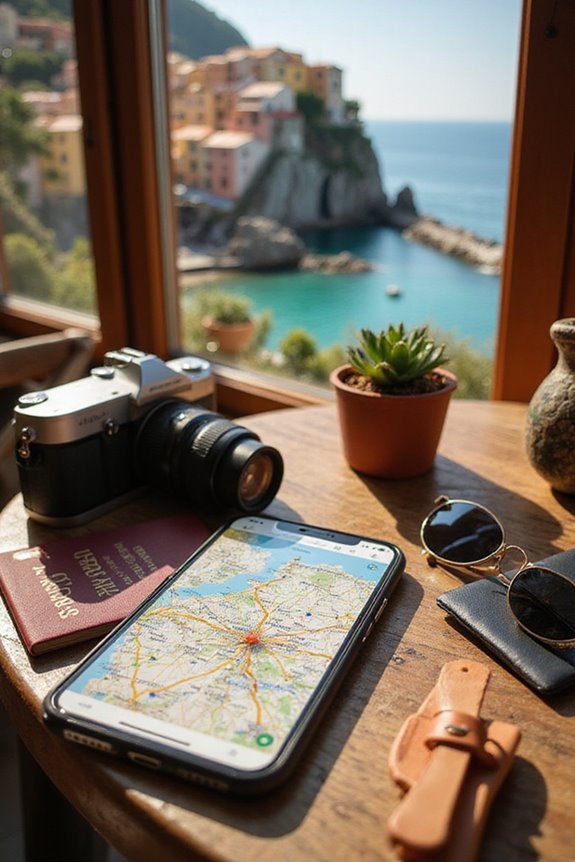Finding reliable Wi-Fi while traveling can be a game changer! I always check for hotspots at cafes, airports, and hotels before my trip. Local SIM cards are super handy for easy communication, while eSIMs are a lifesaver—no more roaming fees! If I’m in a remote area, I often rent a portable Wi-Fi device; it’s like having an internet buddy everywhere I go. I learned the hard way to verify networks first, so stick around to discover more tips!
Key Takeaways
- Research Wi-Fi options at hotels, cafes, and airports before traveling to ensure reliable connectivity.
- Read traveler reviews to identify locations with strong and dependable Wi-Fi.
- Consider local SIM cards or eSIM technology for seamless communication and internet access.
- Use portable Wi-Fi devices for group connectivity and reliable internet in remote areas.
- Always verify network authenticity and use a VPN to secure your data on public Wi-Fi.
Understanding Wi-Fi Hotspots and Their Availability
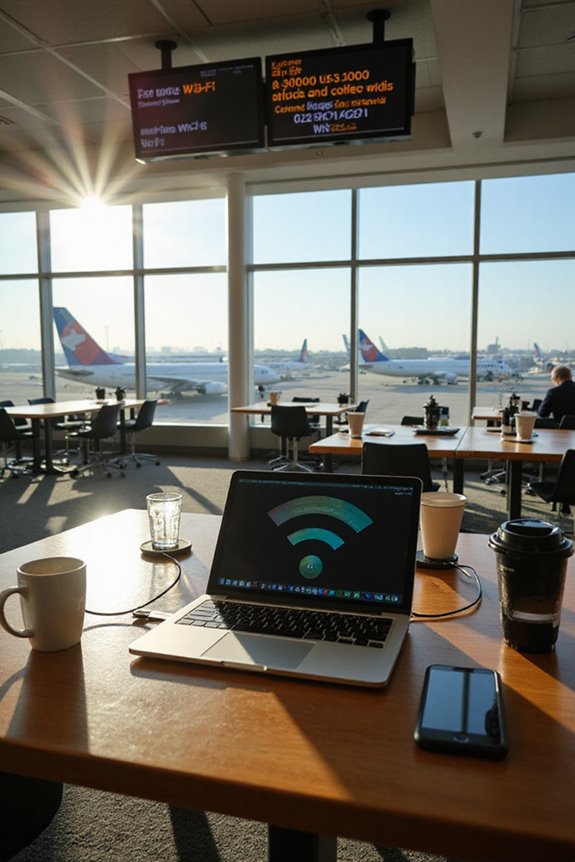
Have you ever found yourself in a cozy café, sipping your favorite brew, only to realize you need a reliable Wi-Fi connection to catch up on emails or post that vacation pic? Trust me, I’ve been there, too! With public hotspots springing up everywhere—think airports, restaurants, and libraries—finding hotspot locations isn’t too hard. However, the connection quality can be hit or miss. I once logged into a restaurant Wi-Fi that was so slow I thought it was stuck in the dial-up era. In late 2021, the world saw over 542 million hotspots, making online access easier than ever. Just remember to stay cautious and enjoy those sweet free internet vibes while you can!
Using Local SIM Cards for Seamless Connectivity

When you’re hopping from one tourist hotspot to another, nothing beats the convenience of a local SIM card for staying connected. I can’t tell you how many times I’ve wandered through markets trying to find my way, only to realize I needed GPS. Local SIM advantages? They give you a local number, making communication with residents a breeze. Plus, purchasing local SIMs at airports is quick and easy, letting you activate your card and start enjoying mobile data almost immediately. They’re usually way more affordable than roaming fees, especially for longer stays, and you can pick from various prepaid plans that fit your needs. Trust me, switching to a local SIM changes the travel game completely!
Exploring the Benefits of Esim Technology
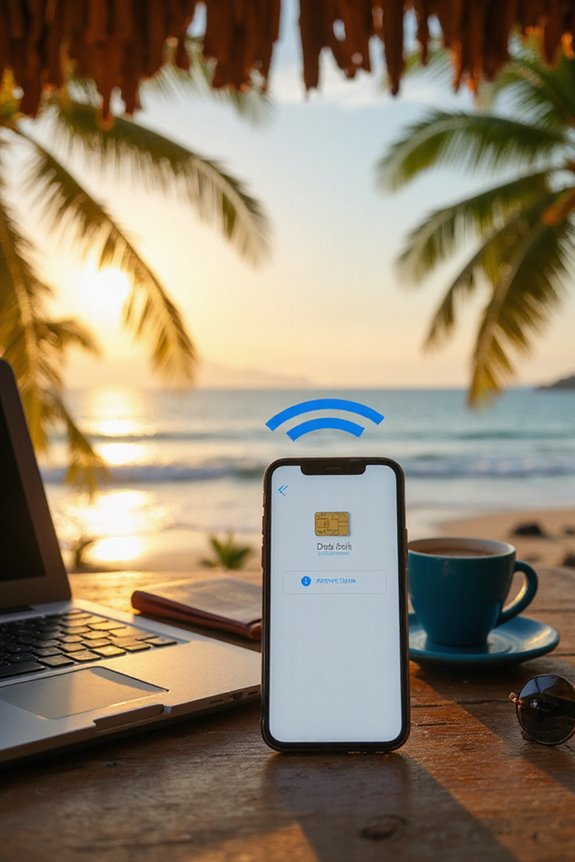
I could go on and on about how great eSIM technology is, but let me just say this: it’s a game changer for travelers like us. The eSIM advantages are clear—no more overpriced roaming fees or scrambling for local SIM cards. With just a scan of a QR code, I can activate my plan and stay connected instantly. Talk about eSIM convenience! I can switch profiles as I hop from country to country, all while keeping my primary number active. Plus, the impressive variety of plans means I can choose one that fits my budget perfectly. And honestly, who doesn’t love reducing plastic waste? Embracing eSIM is not just smart; it’s like having a travel buddy in your pocket!
The Advantages of Portable Wi-Fi Devices
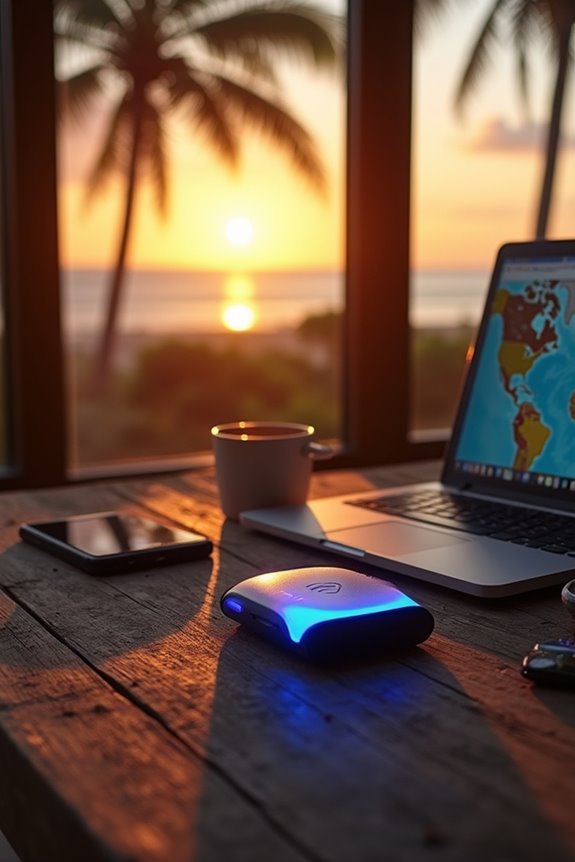
While traveling, nothing beats the convenience of having a portable Wi-Fi device by your side. Seriously, it’s like carrying your own internet hotspot! I love how I can connect 20-30 devices at once—the perfect solution for group connectivity. Instead of scrambling for individual SIM cards, we simply share one device, making it cost-effective and hassle-free. Plus, with its strong signal reach, I can enjoy reliable internet even in the most remote spots. And let’s be real—paying for those outrageous international roaming charges is a no-go! With a portable device, we avoid public Wi-Fi jitters by having a secure, password-protected connection wherever I roam. It really frees me up to navigate, stream, and stay connected without a worry. Additionally, many modern portable Wi-Fi devices offer advanced security features to protect your data while connected to the internet.
Factors Influencing Fast Wi-Fi in Travel Decisions
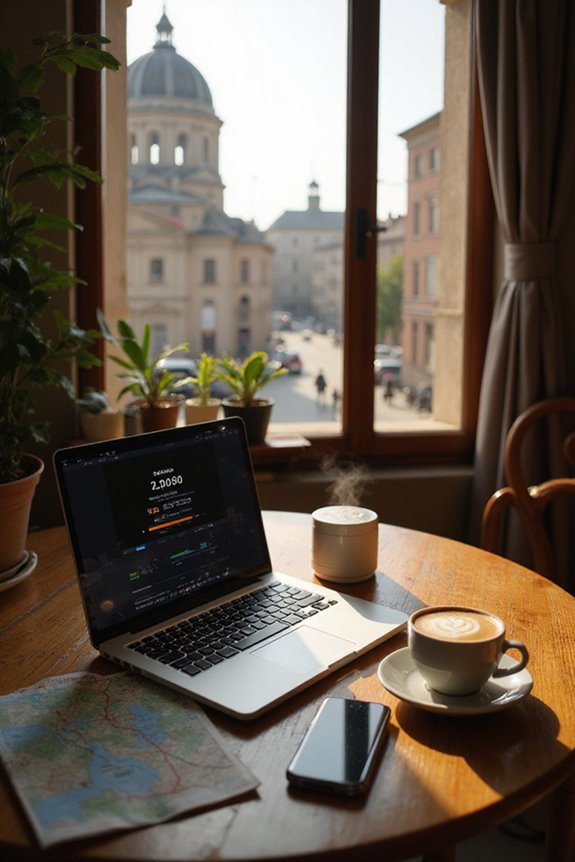
Finding reliable Wi-Fi isn’t just a nice bonus; it can make or break a travel experience. When I’m planning a trip, my Wi-Fi expectations are high. I look for places with stable connections and fast speeds, because who wants to deal with lag in a new city? The convenience of easily accessible Wi-Fi seriously enhances my comfort. Imagine trying to find directions or make last-minute bookings without a solid connection—stressful, right? Cities that offer free Wi-Fi not only keep me connected but also boost my enjoyment of the destination. The right Wi-Fi can even influence my choice of where to stay. After all, a smooth online experience can transform a simple trip into an unforgettable adventure!
Ensuring Security and Privacy on Public Wi-Fi
When you’re out and about, scrolling through Wi-Fi options can feel like a game of Russian roulette, especially if you’re relying on public networks. To keep my data safe, I always check the network authentication with venue staff first; you don’t want to connect to some “evil twin” hotspot, right? I avoid those suspiciously generic networks that don’t require a password—yikes! Also, I make sure to disable auto-connect on my devices and change privacy settings to prevent unauthorized access. Using a VPN is a must for encrypting my internet traffic. I steer clear of banking and sensitive sites too, only sticking to URLs with that reassuring padlock icon. Your online safety matters, so take these steps seriously!
Tips for Researching Wi-Fi Options Before Travel
What’s the best way to stay connected while globetrotting? I’ve learned that researching Wi-Fi options before a trip can save you headaches later. First, check common Wi-Fi sources like hotels, cafes, and airports. I love browsing traveler reviews—you wouldn’t believe the hidden gems people discover! If you’re looking for something special, see if eduroam is available, especially if you’re associated with an academic institution. Don’t forget about local SIM cards; releasing your phone could open up a world of reliable internet. Portable Wi-Fi router rentals are also great for remote areas. Trust me, knowing what Wi-Fi sources to expect gives you more freedom to explore, minus the connectivity worries. Happy travels!
Preparing Multiple Connectivity Solutions
Even if I’m bound for a remote corner of the world, making certain I have multiple connectivity solutions is essential for a stress-free adventure. I’ve discovered that multi-carrier routers can be game changers; they snag the strongest signal wherever I go, which beats the frustration of losing service. For group travels, they’re perfect since they support multiple devices. Plus, I can’t emphasize enough the importance of load balancing. By combining cellular hotspots and other internet connections, I guarantee I stay connected, even when one network gives up. I’ve learned to keep portable hotspots handy too, especially those using eSIM technology. They’re lifesavers for quick access, helping me stay online without a hitch, no matter where I roam!
Leveraging Apps for Finding Reliable Wi-Fi
How often have you found yourself frantically searching for reliable Wi-Fi while traveling, feeling like you’re on a wild goose chase? I’ve been there! That’s where the WiFi Map app comes in. It’s a lifesaver, boasting over 150 million hotspots thanks to user contributions. You can easily find available networks near you, along with passwords and extra info. Even when you’re offline, you can download maps for those times when you’re stuck in the middle of nowhere. Plus, it rates the hotspots, so you can skip the slow connections that make you want to pull your hair out. Seriously, this app can turn your Wi-Fi woes into smooth surfing while you travel.
Staying Within Data Limits and Monitoring Usage
While I don’t claim to be a data wizard, I’ve definitely learned the hard way that staying within data limits while traveling is no walk in the park. I remember a trip where I thought I could binge-watch a series on the go, and poof—my data was gone in a flash! That’s when I discovered the wonders of data tracking. I now monitor my usage religiously, keeping an eye on those sneaky apps like streaming services that can guzzle data. Setting usage alerts in my phone’s settings helps a ton, too. Plus, I always download offline content and limit video quality. Trust me, keeping tabs on my data has saved me from some nasty surprise bills!
Frequently Asked Questions
What Are the Best Countries for Reliable Public Wi-Fi Access?
When I think of top Wi-Fi countries, I contrast bustling cities with serene towns. Lithuania and Croatia shine for public connectivity options, while Singapore’s hotspots blanket urban areas, ensuring I stay connected no matter where I roam.
How Can I Improve Wi-Fi Signal Strength While Traveling?
I’ve found that using Wi-Fi boosters and signal amplifiers truly helps boost my connection. Placing the router centrally and reducing obstructions can make a world of difference when I’m traveling. It’s worth trying!
Are There Any Apps for Finding Free Wi-Fi Hotspots?
I know you might worry about finding internet on the go, but with a Wi-Fi Finder app, like those that offer a hotspot map, I can easily locate free networks anytime, anywhere. It’s a game-changer!
Can I Use Multiple Connectivity Methods Simultaneously?
Yes, you can use multiple connectivity methods simultaneously! I often rely on Wi-Fi aggregation with various connectivity devices, like mobile data and Ethernet, to improve internet speed and guarantee reliable connections during my travels.
What to Do if Wi-Fi Is Unavailable at My Accommodation?
If Wi-Fi’s unavailable at my accommodation, I often rely on local cafes for free access or use portable routers. They’ve saved me countless times when I need reliable connectivity on the go.



